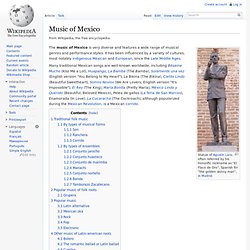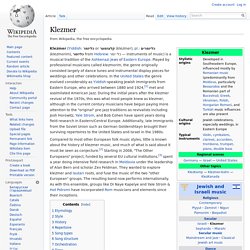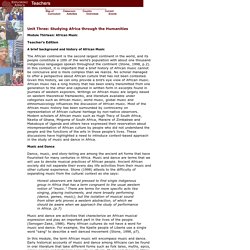

Music of Mexico. Statue of Agustín Lara, often referred by his honorific nickname as "El Flaco de Oro", Spanish for "the golden skinny man", in Madrid.

The music of Mexico is very diverse and features a wide range of musical genres and performance styles. It has been influenced by a variety of cultures, most notably indigenous Mexican and European, since the Late Middle Ages. Mexican Music - Los Nietos - Coqueta. Klezmer. Klezmer (Yiddish: כליזמר or קלעזמער (klezmer), pl.: כליזמרים (klezmorim), כליזמר from Hebrew: כלי זמר — instruments of music) is a musical tradition of the Ashkenazi Jews of Eastern Europe.

Played by professional musicians called klezmorim, the genre originally consisted largely of dance tunes and instrumental display pieces for weddings and other celebrations. In the United States the genre evolved considerably as Yiddish-speaking Jewish immigrants from Eastern Europe, who arrived between 1880 and 1924,[1] met and assimilated American jazz. During the initial years after the klezmer revival of the 1970s, this was what most people knew as klezmer, although in the current century musicians have begun paying more attention to the "original" pre-jazz traditions as revivalists including Josh Horowitz, Yale Strom, and Bob Cohen have spent years doing field research in Eastern/Central Europe. Etymology[edit] Style[edit] Klezmar Musical Instruments. Itzhak Perlman plays Klezmer. Indonesian music. Indonesian Musical Instruments. Indonesian folk music.
Music of Japan. The music of Japan includes a wide array of performers in distinct styles both traditional and modern.

The word for music in Japanese is 音楽 (ongaku), combining the kanji 音 ("on" sound) with the kanji 楽 ("gaku" enjoy).[1] Japan is the second largest music market in the world, with a total retail value of 4,422.0 million dollars in 2012 and most of the market is dominated by Japanese artists with 44 of the top 50 best selling albums[2] and 46 of the top 50 best selling singles in 2013.[3] Local music often appears at karaoke venues, which is on lease from the record labels. Traditional Japanese music is quite different from Western music as it is often based on the intervals of human breathing rather than mathematical timing.[4] Traditional and folk music[edit] Originating as early as the 13th century are honkyoku (本曲 "original pieces"). Traditional music[edit] Biwa hōshi, Heike biwa, mōsō, and goze[edit] Taiko[edit] Taiko performing.
Traditional Japanese Music 1. Japanese Musical Instruments. Celtic music. Celtic music is a broad grouping of musical genres that evolved out of the folk musical traditions of the Celtic people of Western Europe.[1][2] It refers to both orally-transmitted traditional music and recorded music and the styles vary considerably to include everything from "trad" (traditional) music to a wide range of hybrids.

Often the melodic line moves up and down the primary chords in so many songs. There are a number of possible reasons for this: Melodic variation can be easily introduced. These two latter usage patterns may simply be remnants of formerly widespread melodic practices. Often, the term Celtic music is applied to the music of Ireland and Scotland because both lands have produced well-known distinctive styles which actually have genuine commonality and clear mutual influences. The definition is further complicated by the fact that Irish independence has allowed Ireland to promote 'Celtic' music as a specifically Irish product. Divisions[edit] Celtic Musical Instruments. Celtic Spirits by James Littleton. Exploring Africa. Module Thirteen: African Music Teacher's Edition A brief background and history of African Music The African continent is the second largest continent in the world, and its people constitute a 10th of the world’s population with about one thousand indigenous languages spoken throughout the continent (Stone, 1998, p.2).

In this context, it is important that a brief history of African music cannot be conclusive and is more complex than we realize. No scholar managed to offer a perspective about African culture that has not been contested. Music and Dance Dance, music, and story-telling are among the ancient art forms that have flourished for many centuries in Africa. Honest observers are hard pressed to find single indigenous group in Africa that has a term congruent to the usual western notion of “music.” Music and dance are activities that characterize an African musical expression and play an important part in the lives of the people (Senogan-Zake, 1986).
Oral traditions Religious Beliefs. African Musical Instruments. African Music.